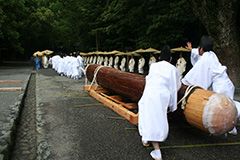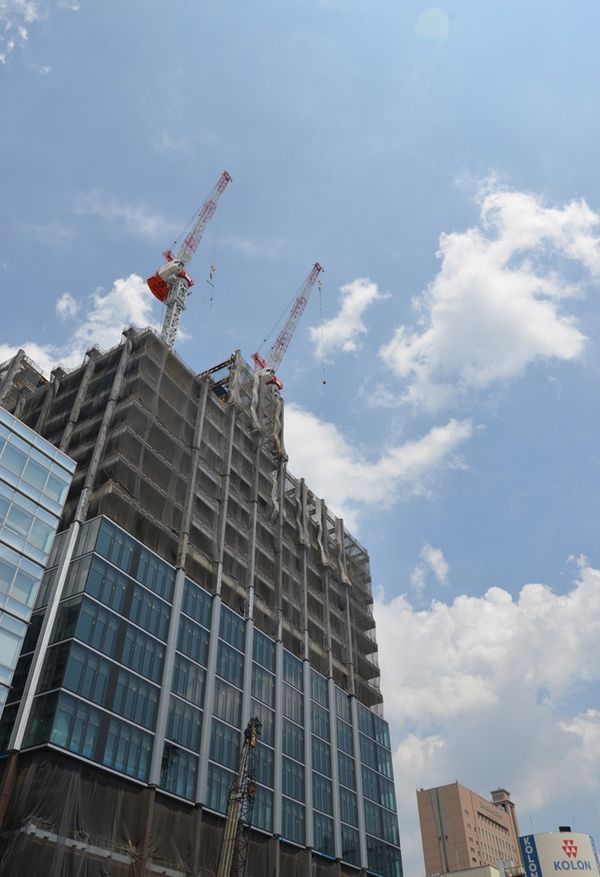The Sun Goddess Moves House
Economy Culture- English
- 日本語
- 简体字
- 繁體字
- Français
- Español
- العربية
- Русский
Late on the evening of Wednesday, October 2, one of the most important events in the Japanese religious calendar took place when the chief deity of the Grand Shrine at Ise moved into new lodgings for the first time in 20 years.
The ritual is the climax of a massive rebuilding project that dates back some 1,300 years. Located in Mie Prefecture, the Ise Shrine has close ties to the imperial family and is considered to be the most sacred site in Shinto. The shikinen sengū rebuild takes place every 20 years, and is believed to represent the agelessness and eternal youth of the Ise Shrine and the gods who dwell there. Because they are rebuilt on a regular basis to exactly the same specifications, the shrine buildings manage to be almost literally timeless: both unimaginably old and obviously new at the same time.
Hidden from prying eyes behind high wooden fences, the wooden shrine buildings and their thatched roofs represent an ancient style of Japanese architecture that is used in no other shrine in the country. Over the past few months, the buildings have been dismantled and rebuilt with fresh materials on an adjacent site roughly 300 meters away. This year was the sixty-second time the shrine has been rebuilt, and the fourth rebuild of the postwar period.
 Shinto priests deliver a huge hinoki cypress into place—one of more than 10,000 used in the rebuild. (Photo courtesy of Ise Jingū.)
Shinto priests deliver a huge hinoki cypress into place—one of more than 10,000 used in the rebuild. (Photo courtesy of Ise Jingū.)
In the ceremony, a sacred mirror representing the deity is solemnly relocated to the newly completed building. Some 150 Shinto priests, along with representatives of the imperial family, were on hand to escort the mirror from the old to the new shrine. All the ritual vestments and votive items used in shrine ceremonies are also replaced. This comes to more than 1,500 items, including ceremonial swords, shields, and spears. More than 10,000 Japanese cypress (hinoki) trees were used to construct the new buildings. The emperor was represented at the ceremony by his daughter, Sayako, who lost her royal status when she married a commoner and now acts as a ceremonial priestess at the shrine—another practice with ancient roots. The emperor himself is reported to have prayed in the direction of Ise from a garden at his palace in Tokyo.
Cranes on the Skyline
The average Japanese house lasts a little longer than one of Ise’s iterations—but not by much. According to statistics put out by the Ministry of Land, Infrastructure, Transport, and Tourism, the average Japanese house or apartment is in use for just 30 years before it is knocked down and replaced. Wars, earthquakes, and a traditional reliance on wood mean that most buildings are considerably younger than the people who live and work in them.
The knock-‘em-down-and-start-again tendency recently got a boost when the prime minster announced that the rate of the consumption tax will increase from 5% to 8% next April. Even before the news was official, there were signs that people were rushing to make big purchases before the new rate kicks in. Statistics released by the MLIT show that construction of new housing was up by 12.8% in July and by 7.7% in August from the same months last year. New construction projects have been on an upward curve for 12 straight months. And the trend is not limited to the capital. In Nagano Prefecture, new housing was up by a whopping 22.4% in August. Contracts signed by the end of September will be taxed at the old rate even if the property is not ready until after April 2014.
 A common sight in the skies near our office.
A common sight in the skies near our office.
The boom is certainly making itself felt in my own Tokyo neighborhood of Setagaya, where there are currently no fewer than three new houses and one large manshon-style apartment building being built within early-morning earshot of my bedroom window. The same is true around the Nippon.com office in central Tokyo. At lunchtime today, I counted five construction sites on a short walk around the block from the office. A commemorative inscription by the entrance reveals that the Nippon Press Center Building was built in 1976—which makes us positively antique by Tokyo standards.
Some economists worry about the slump that might follow when the rush comes to an end. But with the government threatening to put the tax up again to 10% in the not-too-distant future, the sound of banging and drilling is likely to continue for some time yet. As a religious organization, the Ise Shrine is absolved of the need to worry about taxes. This is good news for Amaterasu (or whoever looks after her finances). An estimate in the Yomiuri Shimbun this week suggests that the latest rebuild of the shrine cost somewhere upward of ¥55 billion. (PW)